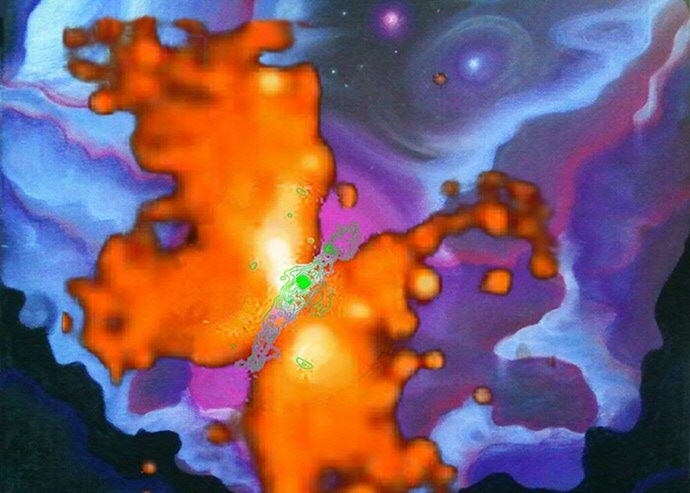Astronomers see mysterious nitrogen area in a butterfly-shaped star formation disk

An international team of astronomers, led by Dutch scientists, has discovered a region in our Milky Way that contains many nitrogen compounds in the southeast of a butterfly-shaped star formation disk and very little in the north-west. The astronomers suspect that multiple stars-to-be share the same star formation disk, but the precise process is still a puzzle. The article with their findings has been accepted for publication in Astronomy & Astrophysics. First and second author are UG and SRON researchers Veronica Allen and Floris van der Tak.
An international team of astronomers studied the star forming region G35.20-0.74N, more than 7000 light years from Earth in the southern sky. The astronomers used the (sub)millimeter telescope ALMA that is based on the Chilean Chajnantor plateau. ALMA can map molecular gas clouds in which stars form.
Something special
The researchers saw something special in the disk around a young, heavy star. While large amounts of oxygen-containing and sulfur-containing hydrocarbons were present throughout the disk, the astronomers found only nitrogen-containing molecules in the southeastern part of the disk. In addition, it was 150 degrees warmer on the nitrogen side than on the other side of the disk.
Based on these observations, the scientists suspect that there are multiple stars forming at the same time in one disk and that some stars are hotter or heavier than others. The researchers expect the disk to eventually break into several smaller disks as the stars grow.
''We have probably been lucky"
A few years ago, there have been observed chemical differences in a star forming region in Orion. First author Veronica Allen (University of Groningen and SRON): "The area in Orion is five times bigger than our area. We have probably been lucky because we expect that such a chemical difference to be short-lived."
Second author Floris van der Tak (University of Groningen and SRON): "Many of the nitrogen molecules are poisonous cyanides. We do not know much about them because it is dangerous to work with those molecules in laboratories on earth."
The astronomers are now investigating the star formation cloud in more detail. Allen: "Maybe we can see the disk break into smaller disks in real time." In addition, the astronomers make models to see how differences in age, mass, temperature or gas density can cause a difference in chemical composition, too.
Veronica Allen
Veronica Allen (USA, 1986) traveled to the United Kingdom to study at the University of Manchester in 2004. However, after her first year, she had to stop because of the high tuition fees for non-EU students. In 2009, she could pursue her studies at EU rate because she then worked in England for five years. In 2013 she obtained her master's degree in astrophysics at the University of Leeds. She has been a PhD student at the Kapteyn Institute in the University of Groningen and SRON since 2014.
Paper
"Chemical Segregation in Hot Cores With Disk Candidates: An investigation with ALMA"
V. Allen, F.F.S. van der Tak, Á. Sánchez-Monge, R. Cesaroni, M.T. Beltrán. Accepted for publication in Astronomy & Astrophysics. (preprint)
Source: news release NOVA
| Last modified: | 06 October 2023 3.00 p.m. |
More news
-
13 May 2024
‘The colourful cells of petals never get boring!’
Most people will enjoy colours in nature. However, the interest of evolutionary biologist Casper van der Kooi goes much further: he studies how flowers, birds, butterflies, and beetles get their colours. He also studies how these colours are used...
-
13 May 2024
Trapping molecules
In his laboratory, physicist Steven Hoekstra is building an experimental set-up made of two parts: one that produces barium fluoride molecules, and a second part that traps the molecules and brings them to an almost complete standstill so they can...
-
07 May 2024
Lecture with soon to be Honorary Doctor Gerrit Hiemstra on May 24
In celebration of his honorary doctorate, FSE has invited Hiemstra to give a lecture entitled ‘Science, let's talk about it’ on the morning of 24 May
